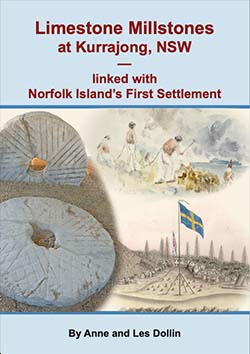
Early History of Flour Milling on Norfolk Island
1788 to 1855
Topics: First and Second Settlements, Nathaniel Lucas, Robert Nash, Norfolk Island Millstones
Singleton Mills homepage > Norfolk Island Flour Milling Overview
British settlement on Norfolk Island
In 1788, 23 British colonists were sent out from Sydney Cove, New South Wales (NSW), Australia, to establish a convict outpost on Norfolk Island.
On this small island (just 35 square km), they were massively isolated from any form of support. They had just made a gruelling eight-month, 24,000 km ocean voyage from England to Australia, and now they were also separated from their parent colony at Sydney Cove in Australia by a further 1,600 km of the Pacific Ocean.
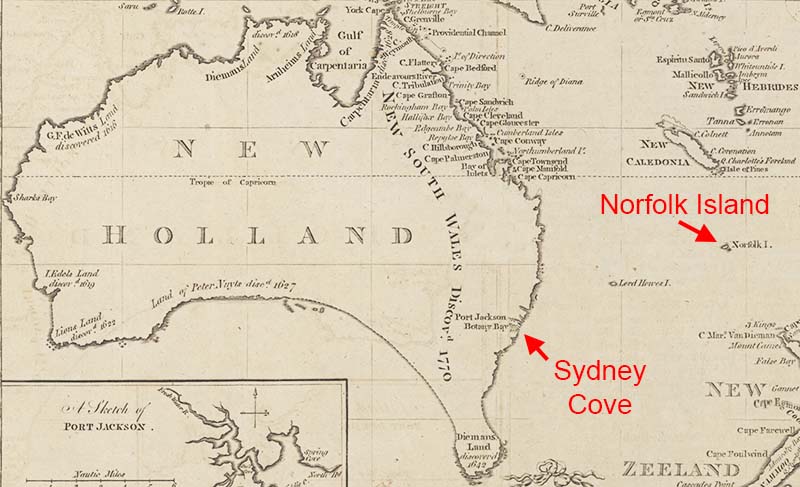
Above, a map, ca. 1790, showing the known coastline of Australia (then called 'New Holland'), as well as the position of the new British colony at Sydney Cove in Port Jackson. Norfolk Island is also shown, 1,600 km from Sydney across the Pacific Ocean. Adapted from a map entitled 'New Holland & the adjacent islands, agreeable to the latest discoveries', National Library of Australia.
When they arrived, Norfolk Island was uninhabited, though East Polynesians had lived there some 400 years earlier. So, the new settlers were entirely dependent upon the stores they had brought with them, and the food they could grow on the island.
As bread was a staple food of these British settlers, they urgently needed to find ways to grind wheat into flour.
In this section of our SingletonMills website, |
We have found important connections between the milling history of Norfolk Island, and early efforts to mill flour in Sydney.
Follow the links below to read about the millstones, handmills, crankmills, watermills, and windmills of the two successive British penal colonies on Norfolk Island:
– the First Settlement - 1788 to 1814, and
– the Second Settlement - 1825 to 1855.
First British Settlement – 1788 to 1814
Lieutenant Philip Gidley King landed on Norfolk Island on 6 March 1788. His small party of 23 people included 15 convicts. However, by 1792, the population of Norfolk Island had grown to a peak of 1156 people, as ship after ship brought more convicts and guards from Sydney, NSW, to the island.[1]
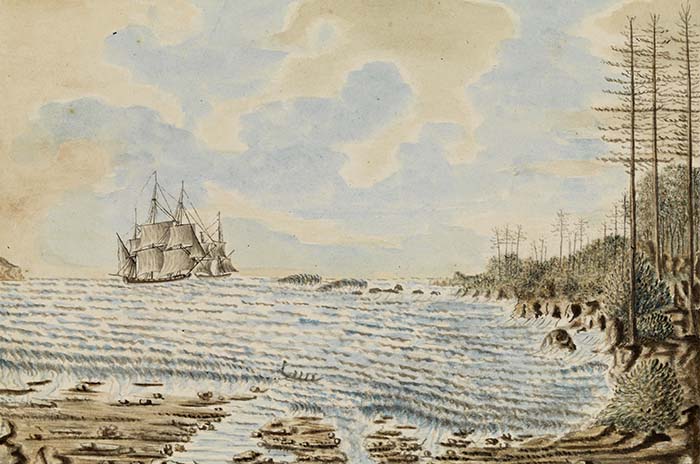
Above, the Sirius and the Supply in the bay adjoining the First Settlement of Norfolk Island in 1790. These ships brought an additional 349 people to the island, including 67 extra convicts. Painting by William Bradley from his journal 'A Voyage to New South Wales'. State Library of NSW.
The First Settlement lasted for 26 years. The British Government finally closed the First Settlement, because they decided it was too expensive to maintain. By that stage, many settlers were well established and very reluctant to leave. Nevertheless, by 1814, all the colonists had been evacuated from the island.
Fortunately, valuable early records about daily life in the settlement were left by Lieutenant King in his detailed diaries. A wealth of fascinating charts and paintings showing the early years of the settlement have also been preserved.[2]

Above, the First Settlement on Norfolk Island in 1790. Painting by George Raper, Natural History Museum, London.
Flour mills during the First Settlement
Read full details about the Norfolk Island First Settlement Flour Mills
The 13 iron hand-powered mills that had been originally supplied to the Norfolk Island settlers rapidly worn out.
However, a large deposit of Calcarenite Limestone was found on the island in 1791, and this proved to be suitable for making millstones.
Calcarenite Limestone Millstones
|
By 1794, small hand-driven mills called 'Querns' were being cut from the Calcarenite and these enabled the settlers to grind small amounts of wheat, after the iron hand mills wore out.
Following this, at least six large-scale flour mills were built on Norfolk Island. These used full-sized millstones quarried from the Calcarenite Limestone.
The mills included:
– Two types of convict-driven mills;
– Two versions of a watermill; and
– Two windmills.
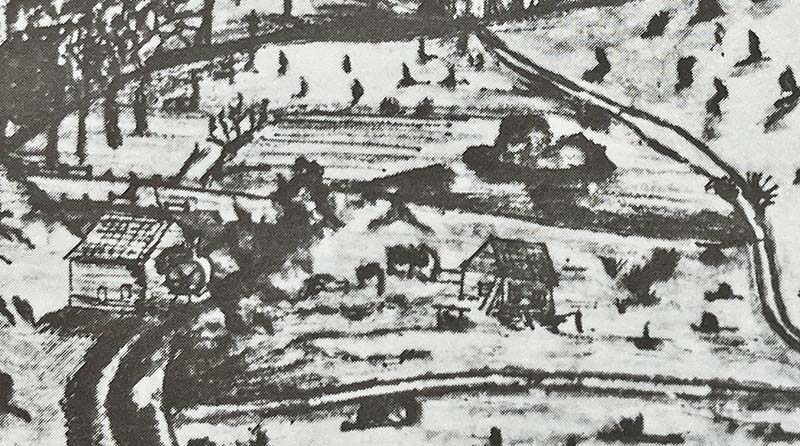
Above, a sketch of the First Settlement watermill (far left) on Norfolk Island. More information. Detail from: 'View of the Water Mill in Arthur's Vale, Norfolk Island', by William Neate Chapman, 1796. State Library of NSW.
One of the original convicts in the Norfolk Island settlement, Nathaniel Lucas, had been trained in carpentry before his conviction. He also had some skills as a millwright. Lieutenant King set Lucas the task of trying to set up some flour mills for the settlement. Over the years, Lucas became a highly successful millwright for the First Settlement.
Then, when the settlement began to be shut down, King asked Lucas to go to Sydney, NSW, because the services of a skilled millwright were urgently needed there. Lucas sailed to Sydney with his family in 1805, taking with him the workings of two windmills and several pairs of Norfolk Island millstones.
After Lucas' departure, another settler, Robert Nash, was involved in flour milling on Norfolk Island, and he built his own flour mill there. When Nash was finally evacuated to Tasmania in 1814, he too may have taken some Norfolk Island millstones with him, and he went on to establish several flour mills in Tasmania.
Read more about the First Settlement Flour Milling on Norfolk Island: •• Iron Hand-Mills •• Stone Querns •• Convict Powered Mills •• Watermills •• Windmills •• Norfolk Island Millstones •• Nathaniel Lucas •• Robert Nash •• |
Second British Settlement – 1825 to 1855
In the 1820s, the British Government decided to re-occupy Norfolk Island, as a penal colony where they could banish their worst convicts.[3]
Sir Ralph Darling, Governor of NSW, said of Norfolk Island in 1827,
'My object was to hold out that Settlement as a place of the extremest punishment, short of Death.'[4]
The first group, of about 100 people, landed at Norfolk Island on 6 June 1825. Initially the population included just 57 convicts, but by 1834 there were nearly 700 convicts. They were led by a series of short-term Supervisors and Commandants.[5]
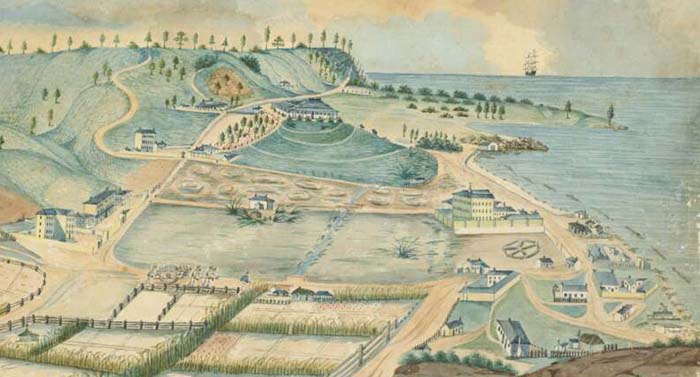
Above, detail from a painting of the Second Settlement on Norfolk Island in about 1839. 'Settlement at Norfolk Island', by Thomas Seller, ca. 1839. National Library of Australia.
The second Settlement lasted until 1855 when it too was closed by Britain. The remaining convicts were sent to Tasmania (then known as Van Diemen's Land).
In the following year, a group of Pitcairn Islanders were resettled onto Norfolk Island by the British Government. They took over many of the remaining buildings and made use of Second Settlement flour mills – although the Islanders preferred their traditional diet, rich in potatoes, yams, and taro.[6]
Flour mills during the Second Settlement
Read full details about the Norfolk Island Second Settlement Flour Mills
In 1828, work began to construct a water-driven flour mill in Arthurs Vale. It used the dam and mill races dug for the First Settlement watermill, but the mill building itself had to be completely rebuilt.[7]
Then, in the late 1830s, a crankmill powered by convicts was set up to mill the settlement's flour, because harsh penal punishment was the key purpose of the Second Norfolk Island Settlement. An even more-gruelling treadmill design was also proposed, but this was never constructed.
A fascinating horizontal windmill was built at The Cascade settlement in about the 1840s. Glimpses of the structure of this extremely rare windmill design are provided by a painting, maps, and a design sketch from the period.
An effective windmill using a post-mill design was also built on Point Hunter. In addition, plans survive for a much more elaborate stone windmill, which was proposed and approved in 1845, but never constructed.
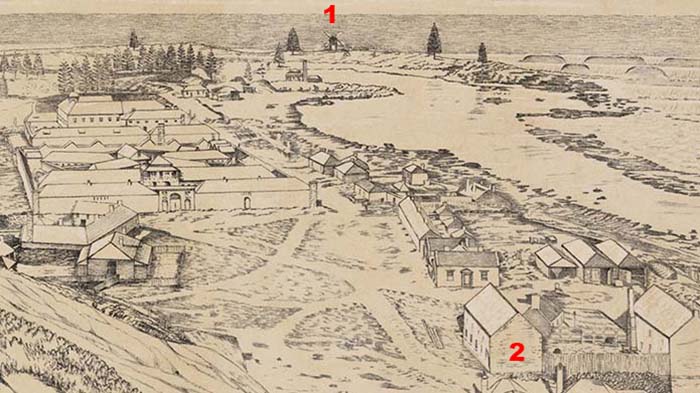
Above, detail from a sketch of the Second Settlement on Norfolk Island, showing a windmill on Point Hunter (1), and the convict crankmill building (2). From 'A view of the settlement, Norfolk Island from the Flagstaff hill' by Robin Vaughan Hood. State Library of NSW.
Numerous millstones would have been used in these many Second Settlement mills. Unfortunately, we have not yet found any documentation about the source of the Second Settlement millstones. However, it is likely that they were quarried from the local Calcarenite Limestone, as they were in the First Settlement.
Read more about Second Settlement Flour Milling on Norfolk Island: •• The Watermill •• The Convict Powered Crankmill •• A Rare Horizontal Windmill •• A Proposed Stone Windmill •• Second Settlement Millstones •• |
The flour milling achievements of the early Norfolk Island settlers
The colonists of both the First and the Second British settlements laboriously established crucial infrastructure for producing flour. Imported mill components were rare. So, through arduous trial and error, they discovered the best local timber and stone resources for building their mills.
The story of how these settlers overcame such severe hardships and extreme isolation to mill their flour is indeed fascinating and thought-provoking. Furthermore, as we have discovered, the achievements of these Norfolk Island millers made a substantial contribution to the early development of the flour industry in Australia.
REFERENCES
1. Nobbs, Raymond (1988) Viewing the first settlement. In: Nobbs, Raymond (ed) Norfolk Island and its first settlement 1788-1814. Library of Australian History.
2. Lieutenant King was Commander of the Norfolk Island settlement during the periods 1788-1790 and 1791-1800; See collections of charts and paintings in the State Library of Tasmania, the State Library of NSW, and the National Library of Australia.
3. Nobbs, Raymond (ed) (1991) Norfolk Island and its second settlement 1825-1855. Library of Australian History.
4. Historical Records of Australia, 10 Feb 1827, Series 1, Vol 13, page 105.
5. NSW State Archives, Norfolk Island guide, https://mhnsw.au/guides/norfolk-island-guide/
6. Hoare, Merval (1978) Norfolk Island. An outline of its history 1774-1977. Second edition. University of Queensland Press, page 75.
7. Martin, E and Cox, P (1991) Rebuilding the settlement. In: Nobbs, Raymond (ed) (1991) Norfolk Island and its second settlement 1825-1855. Library of Australian History, page 104.
Read More About Norfolk Island's Flour Mills
•• Overview •• First Settlement Flour Mills •• Second Settlement Flour Mills •• Nathaniel Lucas •• Robert Nash •• Norfolk Island Millstones ••
